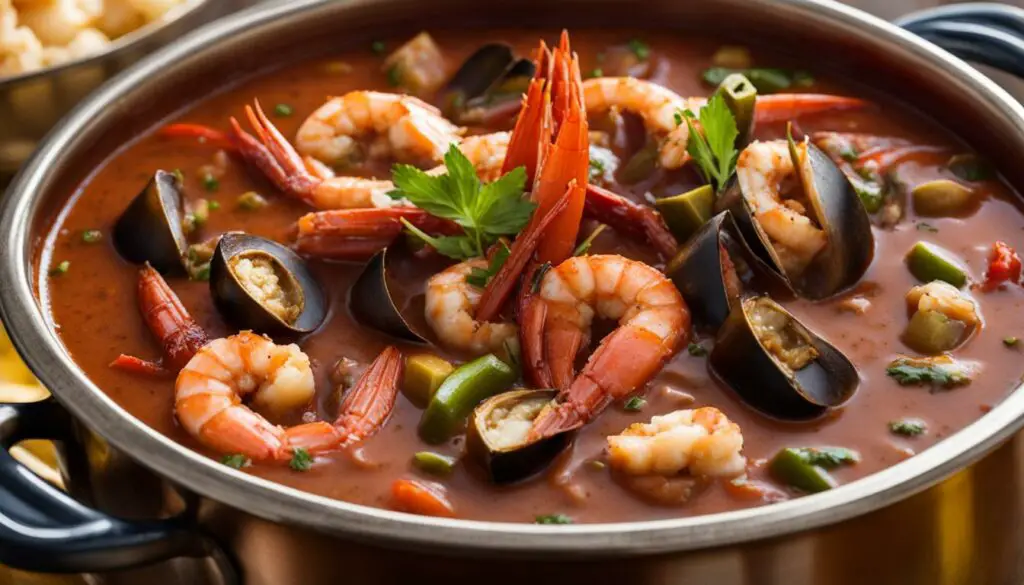Seafood gumbo, a beloved dish in Louisiana cuisine, is a hearty and flavorful stew that combines a variety of seafood, vegetables, and spices. But what if you have leftovers or want to make a big batch to enjoy later? Can you freeze seafood gumbo?
The good news is, yes, you can freeze seafood gumbo for later consumption. Freezing is a convenient way to extend the shelf life of your gumbo and ensure that you can enjoy it at a later time. However, there are some essential food tips you should know to ensure that your gumbo is freezer-safe and maintains its flavor and texture after thawing.
In this section, we’ll answer the question, “Can you freeze seafood gumbo?” and provide essential food tips related to freezing, storing, and maximizing the shelf life of your seafood gumbo.

Key Takeaways:
- Seafood gumbo can be frozen for later consumption.
- Freezing extends the shelf life of gumbo.
- There are essential food tips to follow for freezer-safe gumbo.
- Proper storage and thawing can help maintain the flavor and texture of gumbo.
- Understanding food safety guidelines for gumbo is essential.
Freezing Seafood Gumbo: What You Need to Know
If you want to freeze your seafood gumbo, there are some important things you need to know to ensure it stays fresh and delicious. Freezing food is a great way to extend its shelf life, but it can also affect the flavor and texture of your gumbo if you don’t follow the right steps.
Choosing Freezer-Safe Containers
Firstly, it’s crucial to choose freezer-safe containers. Freezing can cause containers to crack or break, so it’s important to select containers that are specifically designed for freezer storage. Avoid using glass containers, as they can shatter when frozen. Instead, use plastic, BPA-free containers or heavy-duty freezer bags.
Proper Storage Techniques
Once you’ve selected your container, make sure to label it with the date and contents. This will help you keep track of how long it has been frozen and ensure you don’t accidentally defrost the wrong thing. To store gumbo in the freezer, let it cool to room temperature, then transfer it to your chosen container or bag. Be sure to leave some room at the top of the container to allow for expansion as the food freezes. You can store gumbo in the freezer for up to three months.
Guidelines for Thawing Gumbo
When you’re ready to enjoy your gumbo, it’s important to defrost it correctly. The best way to thaw gumbo is to transfer it from the freezer to the fridge and let it defrost there overnight. Avoid defrosting gumbo at room temperature, as this can cause harmful bacteria to grow and compromise the safety of the dish. Once your gumbo is fully thawed, you can reheat it on the stove or in the microwave.
By following these guidelines for freezing, storing, and thawing seafood gumbo, you can ensure that it stays fresh and delicious. Whether you’re meal prepping for the week or saving leftovers for later, proper freezing techniques can help you make the most of your seafood gumbo.
Preserving Flavor and Texture
When it comes to freezing seafood gumbo, preserving its flavor and texture is essential. Follow these tips to keep your gumbo tasting its best.
Defrost Slowly and Gently
When you’re ready to eat your frozen seafood gumbo, it’s important to defrost it properly. Avoid using the microwave or hot water, as this can cause the gumbo to become overcooked and lose its texture. Instead, let the gumbo thaw slowly and gently in the fridge overnight.
Reheat Gently
When reheating your defrosted seafood gumbo, use gentle heat to avoid overcooking it. A low heat, such as a stovetop simmer or a slow cooker, is ideal for preserving the texture and flavor of your gumbo.
Add Fresh Ingredients
To bring back some of the fresh flavor lost during freezing and thawing, consider adding a few fresh ingredients to your reheated gumbo. Chopped herbs, such as parsley or cilantro, or a squeeze of lemon juice can help to brighten up the flavors and make your gumbo taste as fresh as possible.
“When you freeze seafood gumbo, it can lose some of its flavor and texture. But with proper thawing and reheating techniques, you can preserve its delicious taste.”
Food Safety and Seafood Gumbo
When it comes to freezing and thawing seafood gumbo, it’s important to prioritize food safety. While gumbo can be frozen for up to three months, it’s crucial to follow proper thawing and reheating guidelines to prevent the growth of harmful bacteria.
When thawing frozen gumbo, you should always do so in the refrigerator or using the cold water method. Avoid thawing gumbo at room temperature, as this can promote bacterial growth. Once the gumbo is thawed, reheat it to an internal temperature of at least 165°F to ensure it’s safe to consume.
It’s also important to note that seafood in gumbo is a highly perishable food. Any leftovers should be refrigerated or frozen within two hours of cooking to prevent bacterial growth. Additionally, gumbo should be reheated to an internal temperature of at least 165°F before consuming.

You may also like:
Best Appetizers to Serve with Gumbo for a Flavorful Feast
Can You Freeze Seafood Gumbo? Essential Food Tips.
Discover Perfect Combinations with Jambalaya Wine Pairing
Conclusion
Now that you’ve learned about freezing seafood gumbo, you can enjoy this delicious dish anytime, even when you don’t have the time to make it from scratch. To recap, yes, you can freeze seafood gumbo. Just remember to use freezer-safe containers, label them with the date, and follow the proper guidelines for storage and thawing.
Final Thoughts
When it comes to preserving the flavor and texture of your seafood gumbo, a few extra steps can make all the difference. Try to freeze your gumbo as soon as it’s cooled to room temperature and avoid refreezing any leftovers. When reheating your gumbo, make sure it reaches an internal temperature of 165°F to ensure it’s safe to eat.
Lastly, don’t be afraid to experiment with different ingredients and spices to make your seafood gumbo your own. Whether you prefer Cajun or Creole style, with shrimp, crab, or oysters, gumbo is a dish that can be customized to your taste buds. Happy cooking!


